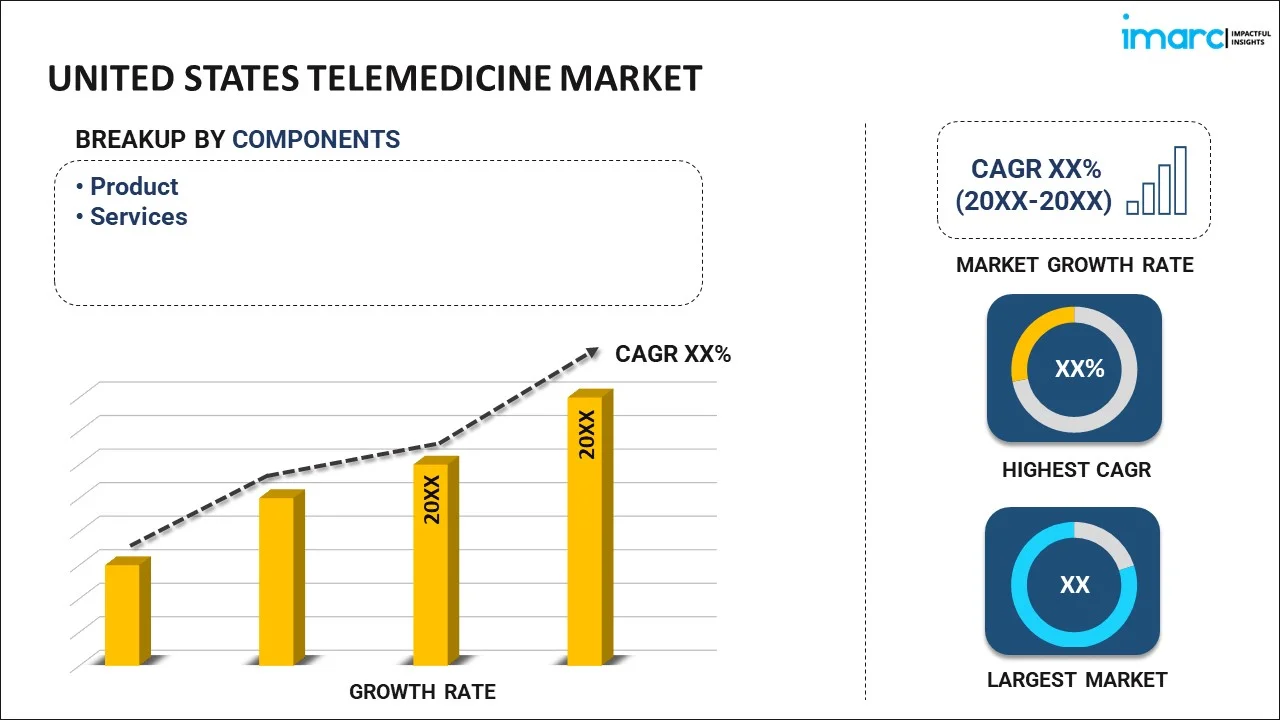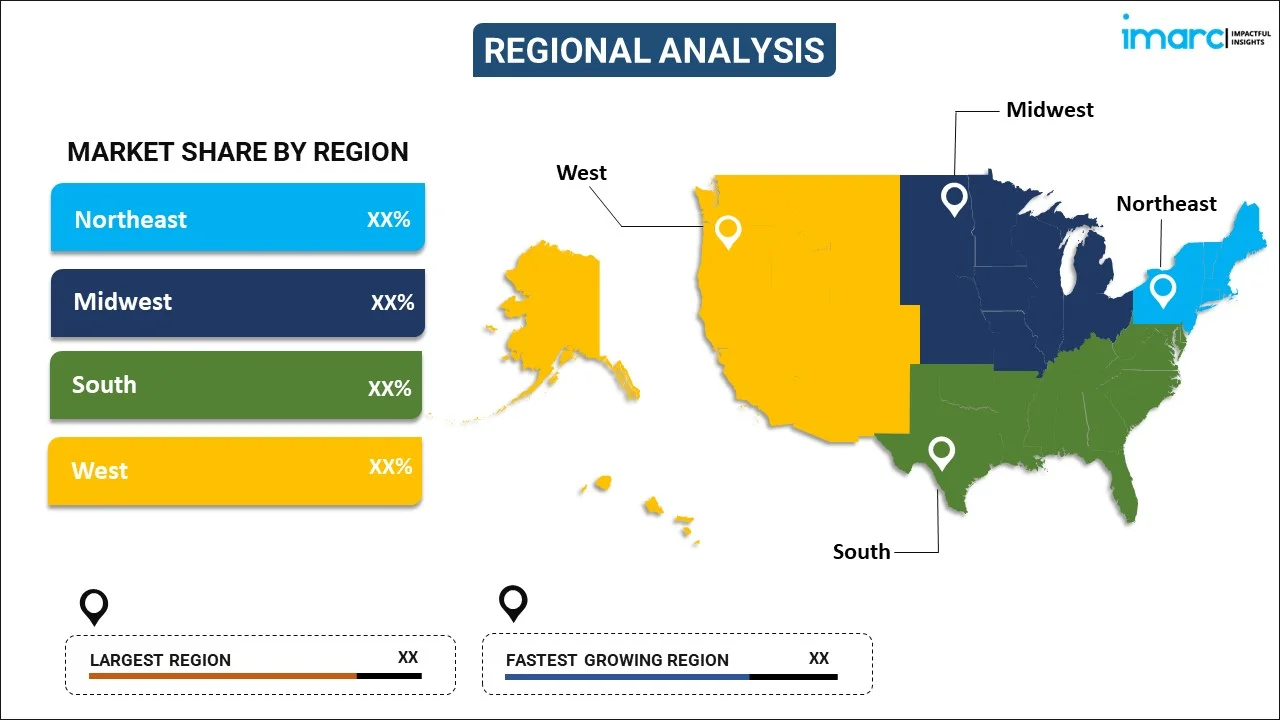
United States Telemedicine Market Report by Component (Product, Services), Modality (Real-Time, Store and Forward, and Others), Delivery Mode (Web/Mobile, Call Centers), Facility (Tele-Hospital, Tele-Home), Application (Teledermatology, Teleradiology, Telepsychiatry, Telepathology, Telecardiology, and Others), End User (Providers, Payers, Patients, and Others), and Region 2025-2033
Market Overview:
United States telemedicine market size reached USD 26.6 Billion in 2024. Looking forward, IMARC Group expects the market to reach USD 128.4 Billion by 2033, exhibiting a growth rate (CAGR) of 17.8% during 2025-2033. The increasing need for telehealth services and various innovations in the healthcare industry are primarily driving the market growth.
|
Report Attribute
|
Key Statistics
|
|---|---|
|
Base Year
|
2024
|
|
Forecast Years
|
2025-2033
|
|
Historical Years
|
2019-2024
|
| Market Size in 2024 | USD 26.6 Billion |
| Market Forecast in 2033 | USD 128.4 Billion |
| Market Growth Rate 2025-2033 | 17.8% |
Telemedicine is a healthcare delivery model that leverages telecommunications technology to facilitate the remote provision of medical services. This approach allows healthcare professionals to interact with patients, diagnose medical conditions, offer treatment recommendations, and provide ongoing care, all without the need for physical presence. Telemedicine encompasses various communication channels such as video calls, audio calls, and secure messaging platforms, enabling patients to access medical expertise from the comfort of their homes. In line with this, the utilization of telemedicine has become increasingly prevalent, offering benefits such as improved accessibility to healthcare services, reduced travel-related inconveniences, and enhanced efficiency in healthcare delivery. Through the integration of technology, telemedicine plays a crucial role in extending medical care to individuals in geographically remote areas, promoting timely interventions, and fostering more accessible and convenient healthcare solutions.
United States Telemedicine Market Trends:
The United States telemedicine market is a dynamic and rapidly evolving sector at the forefront of transforming healthcare delivery. Fueled by factors, such as the growing demand for remote healthcare services, improved access to healthcare in underserved areas, and continuous advancements in telehealth technology and telecommunication infrastructure, the market plays a pivotal role in reshaping the healthcare landscape, which is acting as another significant growth-inducing factor. Furthermore, reimbursement by government bodies for telemedicine services encourages healthcare providers to integrate telehealth into their practice, thereby catalyzing the market growth. Also, the COVID-19 pandemic has accelerated the adoption of telemedicine to ensure continuity of care while minimizing in-person interactions, which is positively influencing the market growth across the country. Besides this, telemedicine not only enhances healthcare access for individuals in remote or underserved regions but also provides a versatile platform for managing chronic conditions, preventive care, mental health services, and follow-up consultations. Moreover, extensive investments by key players in R&D activities will continue to expand the United States telemedicine market over the forecasted period.
United States Telemedicine Market Segmentation:
IMARC Group provides an analysis of the key trends in each segment of the market, along with forecasts at the country level for 2025-2033. Our report has categorized the market based on component, modality, delivery mode, facility, application, and end user.
Component Insights:

- Product
- Hardware
- Software
- Others
- Services
- Tele-Consulting
- Tele-Monitoring
- Tele-Education
The report has provided a detailed breakup and analysis of the market based on the component. This includes product (hardware, software, and others) and services (tele-consulting, tele-monitoring, and tele-education).
Modality Insights:
- Real-Time
- Store and Forward
- Others
A detailed breakup and analysis of the market based on modality have also been provided in the report. This includes real-time, store and forward, and others.
Delivery Mode Insights:
- Web/Mobile
- Audio/Text-Based
- Visualized
- Call Centers
The report has provided a detailed breakup and analysis of the market based on the delivery mode. This includes web/mobile (audio/text-based and visualized) and call centers.
Facility Insights:
- Tele-Hospital
- Tele-Home
A detailed breakup and analysis of the market based on facility have also been provided in the report. This includes tele-hospital and tele-home.
Application Insights:
- Teledermatology
- Teleradiology
- Telepsychiatry
- Telepathology
- Telecardiology
- Others
The report has provided a detailed breakup and analysis of the market based on the application. This includes teledermatology, teleradiology, telepsychiatry, telepathology, telecardiology, and others.
End User Insights:
- Providers
- Payers
- Patients
- Others
A detailed breakup and analysis of the market based on end user have also been provided in the report. This includes providers, payers, patients, and others.
Regional Insights:

- Northeast
- Midwest
- South
- West
The report has also provided a comprehensive analysis of all the major regional markets, which include the Northeast, Midwest, South, and West.
Competitive Landscape:
The market research report has also provided a comprehensive analysis of the competitive landscape in the market. Competitive analysis such as market structure, key player positioning, top winning strategies, competitive dashboard, and company evaluation quadrant has been covered in the report. Also, detailed profiles of all major companies have been provided.
United States Telemedicine Market Report Coverage:
| Report Features | Details |
|---|---|
| Base Year of the Analysis | 2024 |
| Historical Period | 2019-2024 |
| Forecast Period | 2025-2033 |
| Units | Billion USD |
| Scope of the Report | Exploration of Historical Trends and Market Outlook, Industry Catalysts and Challenges, Segment-Wise Historical and Future Market Assessment:
|
| Components Covered |
|
| Modalities Covered | Real-Time, Store and Forward, Others |
| Delivery Modes Covered |
|
| Facilities Covered | Tele-Hospital, Tele-Home |
| Applications Covered | Teledermatology, Teleradiology, Telepsychiatry, Telepathology, Telecardiology, Others |
| End Users Covered | Providers, Payers, Patients, Others |
| Regions Covered | Northeast, Midwest, South, West |
| Customization Scope | 10% Free Customization |
| Post-Sale Analyst Support | 10-12 Weeks |
| Delivery Format | PDF and Excel through Email (We can also provide the editable version of the report in PPT/Word format on special request) |
Key Questions Answered in This Report:
- How has the United States telemedicine market performed so far and how will it perform in the coming years?
- What has been the impact of COVID-19 on the United States telemedicine market?
- What is the breakup of the United States telemedicine market on the basis of component?
- What is the breakup of the United States telemedicine market on the basis of modality?
- What is the breakup of the United States telemedicine market on the basis of delivery mode?
- What is the breakup of the United States telemedicine market on the basis of facility?
- What is the breakup of the United States telemedicine market on the basis of application?
- What is the breakup of the United States telemedicine market on the basis of end user?
- What are the various stages in the value chain of the United States telemedicine market?
- What are the key driving factors and challenges in the United States telemedicine?
- What is the structure of the United States telemedicine market and who are the key players?
- What is the degree of competition in the United States telemedicine market?
Key Benefits for Stakeholders:
- IMARC’s industry report offers a comprehensive quantitative analysis of various market segments, historical and current market trends, market forecasts, and dynamics of the United States telemedicine market from 2019-2033.
- The research report provides the latest information on the market drivers, challenges, and opportunities in the United States telemedicine market.
- Porter's five forces analysis assist stakeholders in assessing the impact of new entrants, competitive rivalry, supplier power, buyer power, and the threat of substitution. It helps stakeholders to analyze the level of competition within the United States telemedicine industry and its attractiveness.
- Competitive landscape allows stakeholders to understand their competitive environment and provides an insight into the current positions of key players in the market.
Need more help?
- Speak to our experienced analysts for insights on the current market scenarios.
- Include additional segments and countries to customize the report as per your requirement.
- Gain an unparalleled competitive advantage in your domain by understanding how to utilize the report and positively impacting your operations and revenue.
- For further assistance, please connect with our analysts.
 Inquire Before Buying
Inquire Before Buying
 Speak to an Analyst
Speak to an Analyst
 Request Brochure
Request Brochure
 Request Customization
Request Customization




.webp)




.webp)












